Mangroves are trees that grow in the coastal waters in tropical and subtropical regions. The term mangrove is also used for referring to the coastal ecosystem having mangrove forests with
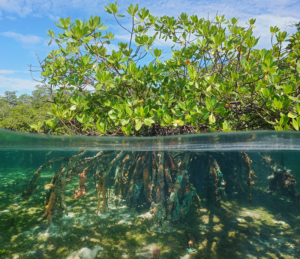
different mangrove species. Some mangrove species grow so close to the shore that the tide submerges their roots and floods them with salt water every day. Mangroves have evolved to have unique characteristics that allow them to thrive in salty, oxygen-depleted soil.
The red mangrove (Rhizophora mangle) is the most common mangrove on the earth. It has colonized various sections of the globe because of its adaptability and long-lived seeds. The red mangrove is known for its massive, arching roots that support the main trunk. These arial roots are covered with air pores which help them respire. The leaves are oval in shape, thick and leathery, and can grow to be 15 cm long and 6 cm wide. They have a dark green lower surface with numerous little reddish-brown spots. They have small, white, creamy flowers.
Mangrove forests provide many important ecological services. Thick root systems of mangrove trees provide a natural barrier against storms and flooding. The roots can trap debris, protecting coastal areas and slowing erosion. Additionally, this filtering process keeps hazardous silt out of coral reefs and seagrass beds. Mangroves also help to combat global warming as they absorb a massive amount of atmospheric carbon dioxide.
Many people who live near or in a region with mangrove forests rely on them for their income. The trees provide a consistent supply of wood for construction and fuel, which is valued for its decay and insect resistance. The mangrove ecosystem supports a diverse range of wildlife, including fish, crabs, mollusks, and sea turtles. A variety of nesting, breeding, and migratory birds use the tangle of trees as a refuge. When mangrove trees are cut down, a significant habitat is lost, putting the survival of a variety of species at risk.
Conservation of mangrove forests throughout the world is crucial. Their number is decreasing more and more each day. Protecting mangrove forests will guard the natural coastal ecosystem. Harvesting mangroves from the wild is restricted in many areas but sadly, the illegal harvesting continues. The aquaculture industry plays a major role in its conservation by providing an alternative to harvesting from the wild.
Now we know what red mangrove is and how important it is for the environment. Let’s discuss how red mangrove can be grown in captivity.
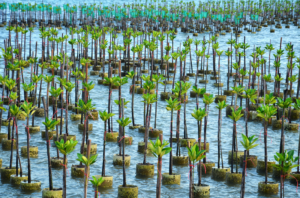
Propagation of red mangrove in captivity:
Growing mangroves in the aquarium is not very difficult. They are not fast-growing trees. Mangrove seeds are called propagules. Red mangrove has long cigar-shaped propagules. They float in a vertical position with roots on the lower side and leaves emerge from above. Red mangrove needs enough space to grow. They should be propagated in an open tank. For optimal growth, closed-canopy tanks should be avoided.
Red mangroves, like other mangrove plants, need a lot of lighting for optimal growth. A suitable amount of light and a humid environment must be provided. If the lamp is close enough to the leaves, a fluorescent lamp should be sufficient. When utilizing fluorescent light like T5 bulbs, it is better to have two or more bulbs. Metal halide bulbs have produced amazing results in the cultivation of red mangrove.
However, just because red mangroves like a lot of strong lighting doesn’t mean they are resistant to burning. The leaves will turn yellow and dry if they are kept too close to the light source. Make sure the bulb and leaves are at least four inches apart. A small aquarium with mangroves can even be set up in a window. Filtered sunlight from a window should be sufficient.
In terms of substrate, mangroves do not require any type of soil or substrate to grow. They grow perfectly well in water with bare roots. Mangroves should be planted on the tops of rocks or in the bottom substrate of a display reef tank for aesthetic purposes.
Mangroves grown in aquariums do not require phosphorous or nitrogen fertilizer because these nutrients are provided by fish food and waste. Other important plant nutrients like potassium, iron, and manganese are also found in fish foods. Supplements containing these nutrients should be added to the water weekly for better growth, especially if large quantities of mangroves are used to filter the water.
They can grow in a variety of water conditions, from sea to fresh, giving the reef keeper the opportunity to design a brackish system structured like an estuarine ecosystem. Although red mangroves will tolerate a wide variety of temperatures, they will not survive freezing temperatures.
Trimming can modify the growth and shape of mangroves. Trimming mangroves is simple. Simply cut the branch, shoot, or aerial root with a clean and sharp knife. Prop roots are usually cut in aquariums or similar situations. The wound will heal quickly, usually within a few days, and normally develop two branches or up to six prop roots that grow directly next to where the mangrove has been cut.
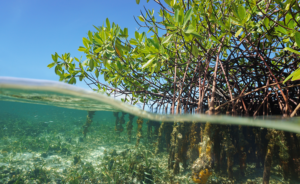
Reasons for adding red mangrove to the reef tank system:
Aquarists grow red mangroves in the reef tank as they look impressive and more natural. They make display tanks attractive. They offer a foraging area for the other inhabitants of the reef tank system. Their propagation is easy and simple. Adding mangroves to your reef tank will benefit all of the animals. Another benefit is improved water quality. Mangroves remove and filter contaminants such as nitrite, nitrate, and phosphate from the water.
The use of aquacultured red mangrove plants over wild-harvested specimens is highly recommended. They are far better acclimated to reef tank life when raised in captivity. They’re also less likely to bring pests and hitchhikers with them. Furthermore, aquacultured specimens are better suited to withstand the stresses of shipping.
Conclusion:
The Red mangrove is a very important mangrove species. It is widely used by hobbyists in their aquariums to make them more attractive. It is a slow-growing plant. It is very beneficial for the overall health of the aquarium as it acts as a natural filter. Its propagation and maintenance are easy. Red Mangrove forests are declining throughout the world.
The aquaculture industry is helping its conservation by giving an alternative to harvesting from the wild. We hope this article has helped to explain how captive-bred mangroves are improving water quality in the of the Gulf of Mexico. Also, the requirements for keeping this magnificent plant are very basic but the benefits are profound!

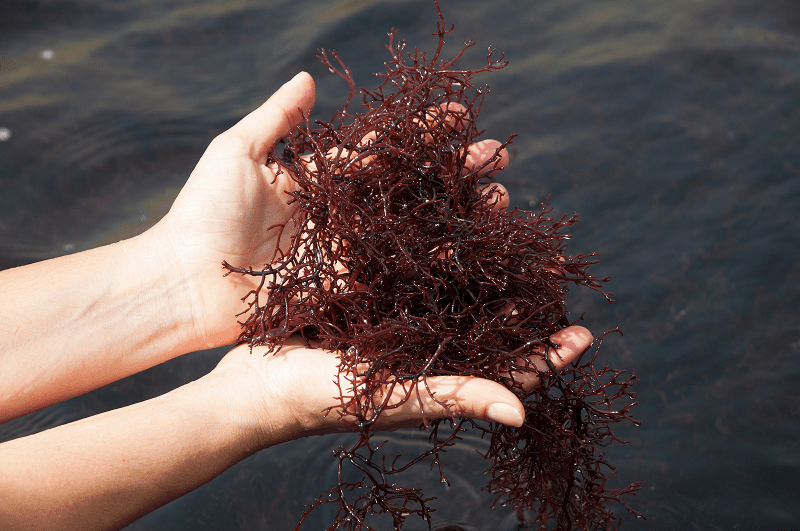


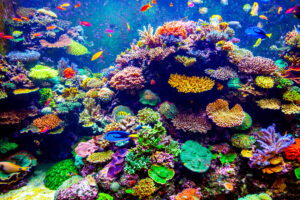

Leave a Reply